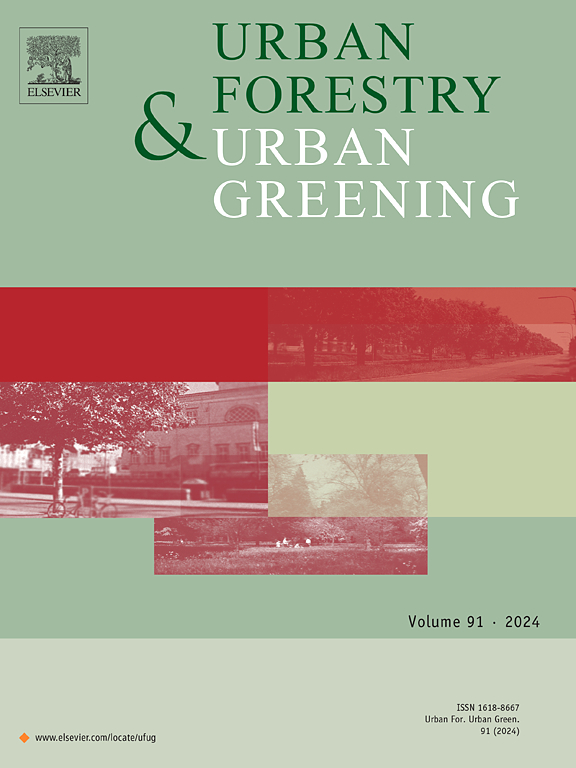Socio-cultural patterns in how residents value and use green space in new greenfield developments
IF 6.7
2区 环境科学与生态学
Q1 ENVIRONMENTAL STUDIES
引用次数: 0
Abstract
Understanding green space values and interactions in greenfield residential estates is crucial for urban planning, yet there is a distinct lack of research on how these culturally diverse, new communities interact with green spaces such as parks and private gardens. This study examines how socio-cultural factors and nature values influence residents’ interactions with green spaces in these new developments. We conducted an online survey of people living in recently developed greenfield estates across three capital cities in Southeast Australia (n = 1041). The survey assessed core nature values and valued attributes of private and public green spaces, visitation frequency of parks and backyards, life satisfaction and nature connection. Respondents also indicated preferences for house and backyard size (keeping land parcel area constant) of a hypothetical future home. Our findings reveal specific socio-cultural differences in values and green space interactions. In our sample, women value social attributes of green spaces more than men, and older people spend more time in private green spaces and value natural attributes of public green space more than younger people. Green space visits were positively associated with nature connection and life satisfaction, but different nature values related to these outcomes in contrasting ways. Notably, 49 % of respondents preferred a smaller home and corresponding larger backyard, when asked about moving into a new home. The results suggest that green spaces in greenfield developments should be designed to maintain a natural landscape while supporting recreation and social interactions. They also emphasise that there is demand for smaller house footprints relative to residential block sizes which could have substantial benefits for urban sustainability.
在新的绿地开发项目中,居民如何评价和使用绿地的社会文化模式
了解绿地住宅小区的绿色空间价值和相互作用对于城市规划至关重要,但对于这些文化多样性的新社区如何与公园和私人花园等绿色空间相互作用的研究明显缺乏。本研究探讨了社会文化因素和自然价值观如何影响这些新开发项目中居民与绿地的互动。我们对居住在澳大利亚东南部三个首府城市最近开发的绿地中的人们进行了在线调查( = 1041)。该调查评估了核心自然价值和私人和公共绿地的价值属性、公园和后院的访问频率、生活满意度和自然联系。受访者还表示了对房屋和后院大小(保持土地面积不变)的偏好。我们的研究结果揭示了价值观和绿地互动方面的特定社会文化差异。在我们的样本中,女性比男性更看重绿地的社会属性,老年人比年轻人更看重公共绿地的自然属性,而在私人绿地上花费更多的时间。绿色空间访问与自然联系和生活满意度呈正相关,但不同的自然价值观对这些结果的影响方式不同。值得注意的是,当被问及搬进新家时,49% %的受访者更喜欢小一点的房子和相应大一点的后院。研究结果表明,绿地开发项目中的绿地应在保持自然景观的同时,支持娱乐和社交活动。他们还强调,相对于住宅楼而言,人们需要更小的房屋面积,这可能对城市的可持续性有实质性的好处。
本文章由计算机程序翻译,如有差异,请以英文原文为准。
求助全文
约1分钟内获得全文
求助全文
来源期刊

Urban Forestry & Urban Greening
FORESTRY-
CiteScore
11.70
自引率
12.50%
发文量
289
审稿时长
70 days
期刊介绍:
Urban Forestry and Urban Greening is a refereed, international journal aimed at presenting high-quality research with urban and peri-urban woody and non-woody vegetation and its use, planning, design, establishment and management as its main topics. Urban Forestry and Urban Greening concentrates on all tree-dominated (as joint together in the urban forest) as well as other green resources in and around urban areas, such as woodlands, public and private urban parks and gardens, urban nature areas, street tree and square plantations, botanical gardens and cemeteries.
The journal welcomes basic and applied research papers, as well as review papers and short communications. Contributions should focus on one or more of the following aspects:
-Form and functions of urban forests and other vegetation, including aspects of urban ecology.
-Policy-making, planning and design related to urban forests and other vegetation.
-Selection and establishment of tree resources and other vegetation for urban environments.
-Management of urban forests and other vegetation.
Original contributions of a high academic standard are invited from a wide range of disciplines and fields, including forestry, biology, horticulture, arboriculture, landscape ecology, pathology, soil science, hydrology, landscape architecture, landscape planning, urban planning and design, economics, sociology, environmental psychology, public health, and education.
 求助内容:
求助内容: 应助结果提醒方式:
应助结果提醒方式:


